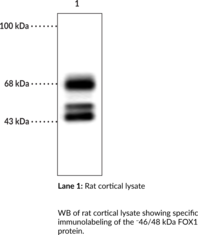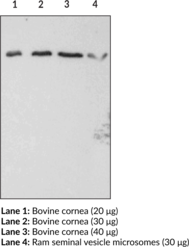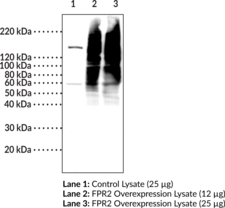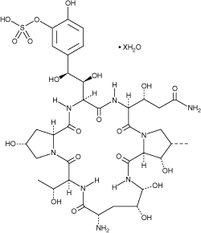Cayman
Showing 21151–21300 of 45550 results
-
Fosmidomycin is an antibiotic originally isolated from culture broths of bacteria of the genus Streptomyces that inhibits DOXP reductoisomerase, a key enzyme in the non-mevalonate pathway of isoprenoid biosynthesis.{26496} Fosmidomycin is active against both Gram-negative and Gram-positive bacteria and the human malarial parasite P. falciparum (IC50 = 290-370 nM).{26495}
Brand:CaymanSKU:-Fosmidomycin is an antibiotic originally isolated from culture broths of bacteria of the genus Streptomyces that inhibits DOXP reductoisomerase, a key enzyme in the non-mevalonate pathway of isoprenoid biosynthesis.{26496} Fosmidomycin is active against both Gram-negative and Gram-positive bacteria and the human malarial parasite P. falciparum (IC50 = 290-370 nM).{26495}
Brand:CaymanSKU:-Fosphenytoin is a prodrug of phenytoin that is rapidly converted to phenytoin, a voltage-gated sodium channel blocker, in vivo.{39387,39386,39385} It induces less tissue damage compared with two other phenytoin prodrugs in rats following subcutaneous and intramuscular administration.{39387} Fosphenytoin has anticonvulsant activity in a mouse model of maximal electroshock seizures similar to that of phenytoin (ED50s = 16 and 8 mg/kg, respectively).{39386} It also has antiarrhythmic activity in isolated guinea pig atria and in anesthetized dogs. Formulations containing fosphenytoin have been used in the treatment of status epilepticus.
Brand:CaymanSKU:23889 - 100 mgAvailable on backorder
Fosphenytoin is a prodrug of phenytoin that is rapidly converted to phenytoin, a voltage-gated sodium channel blocker, in vivo.{39387,39386,39385} It induces less tissue damage compared with two other phenytoin prodrugs in rats following subcutaneous and intramuscular administration.{39387} Fosphenytoin has anticonvulsant activity in a mouse model of maximal electroshock seizures similar to that of phenytoin (ED50s = 16 and 8 mg/kg, respectively).{39386} It also has antiarrhythmic activity in isolated guinea pig atria and in anesthetized dogs. Formulations containing fosphenytoin have been used in the treatment of status epilepticus.
Brand:CaymanSKU:23889 - 250 mgAvailable on backorder
Fosphenytoin is a prodrug of phenytoin that is rapidly converted to phenytoin, a voltage-gated sodium channel blocker, in vivo.{39387,39386,39385} It induces less tissue damage compared with two other phenytoin prodrugs in rats following subcutaneous and intramuscular administration.{39387} Fosphenytoin has anticonvulsant activity in a mouse model of maximal electroshock seizures similar to that of phenytoin (ED50s = 16 and 8 mg/kg, respectively).{39386} It also has antiarrhythmic activity in isolated guinea pig atria and in anesthetized dogs. Formulations containing fosphenytoin have been used in the treatment of status epilepticus.
Brand:CaymanSKU:23889 - 50 mgAvailable on backorder
Fosphenytoin is a prodrug of phenytoin that is rapidly converted to phenytoin, a voltage-gated sodium channel blocker, in vivo.{39387,39386,39385} It induces less tissue damage compared with two other phenytoin prodrugs in rats following subcutaneous and intramuscular administration.{39387} Fosphenytoin has anticonvulsant activity in a mouse model of maximal electroshock seizures similar to that of phenytoin (ED50s = 16 and 8 mg/kg, respectively).{39386} It also has antiarrhythmic activity in isolated guinea pig atria and in anesthetized dogs. Formulations containing fosphenytoin have been used in the treatment of status epilepticus.
Brand:CaymanSKU:23889 - 500 mgAvailable on backorder
Fostriecin is an inhibitor of the serine/threonine protein phosphatases 2A (PP2A) and 4 (PP4) (IC50s = 3.2 and 3 nM, respectively).{23816,23817} It less effectively inhibits topoisomerase II and PP1 (IC50s = 40 and 131 μM, respectively) and does not inhibit PP2B.{23816,21678} Through its effects on protein phosphatases, fostriecin increases the level of histone H3 phosphorylation and may alter epigenetic regulation of cell proliferation.{18481} On a related note, fostriecin was first identified as an antitumor antibiotic.{23815}
Brand:CaymanSKU:-Fostriecin is an inhibitor of the serine/threonine protein phosphatases 2A (PP2A) and 4 (PP4) (IC50s = 3.2 and 3 nM, respectively).{23816,23817} It less effectively inhibits topoisomerase II and PP1 (IC50s = 40 and 131 μM, respectively) and does not inhibit PP2B.{23816,21678} Through its effects on protein phosphatases, fostriecin increases the level of histone H3 phosphorylation and may alter epigenetic regulation of cell proliferation.{18481} On a related note, fostriecin was first identified as an antitumor antibiotic.{23815}
Brand:CaymanSKU:-Immunogen: Recombinant protein from the N-terminus of human FOX1 expressed in E. coli • Host: Mouse • Species Reactivity: (+) Human, Bovine, Mouse, Rat • Applications: IF, WB • MW = ~46/48 kDa
Brand:CaymanSKU:29264- 100 µgFOX1, also known as ataxin-2-binding protein 1 (A2BP1) and RNA binding protein fox-1 homolog 1 (RBFOX1), is an RNA binding protein and alternative splicing regulator encoded by RBFOX1 in humans.{55207,55208,55209} RBFOX1 is expressed in the brain, skeletal muscle, and heart and undergoes splicing to generate tissue-specific isoforms.{55215} Neuron-specific FOX1 regulates alternative splicing of genes involved in neuronal development, proliferation, and maintenance.{55207} Mutations in RBFOX1, including exon deletion, frameshift, and copy number mutations, have been found in patients with rolandic epilepsy, autism, and schizophrenia.{55208,55220,55223} Cayman’s FOX1 Monoclonal Antibody can be used for immunofluorescence (IF) and Western blot (WB) applications. The antibody recognizes FOX1 isoforms at approximately 46 and 48 kDa from human, bovine, mouse, and rat samples.
Brand:CaymanSKU:29264 - 100 µgAvailable on backorder
Immunogen: Recombinant protein from the N-terminus of human FOX1 expressed in E. coli • Host: Mouse • Species Reactivity: (+) Human, Bovine, Mouse, Rat • Applications: IF, WB • MW = ~46/48 kDa
Brand:CaymanSKU:29264- 100 µgAvailable on backorder
Immunogen: Synthetic peptide from the N-terminal cytoplasmic region of mouse protein FP receptor • Host: Rabbit • Application: WB • Species reactivity: (+) Human, bovine, mouse, ovine, and rat • The FP receptor is a G protein-coupled receptor known to elicit smooth muscle contraction in a variety of tissues. FP receptor mRNA is found in reproductive, gastric, neural, and ocular tissues, as well as, specialized cells of the kidney.
Brand:CaymanSKU:101802- 1 eaThe prostaglandin F2α receptor (FP receptor) is a G protein-coupled receptor known to elicit smooth muscle contraction in a variety of tissues.{9114} FP receptor mRNA is found in reproductive, gastric, neural, and ocular tissues as well as specialized cells of the kidney.{3160,1374,1680,9666} Two FP receptor isoforms, FPA and FPB have been identified in sheep.{3905} FPB receptor is truncated at the carboxy-terminus thereby preventing desensitization (which normally occurs by protein kinase C phosphorylation of FPA) and produces aberrant signalling in FPB transfectants.{7614,9285} The existence of a truncated human FP isoform responsible for signal-amplification contributing to luteolysis, cell growth, or malignant transformation is currently unknown.{3905,7614,9285,4688} Cayman’s FP Receptor Polyclonal Antibody can be used for Western blot applications. The calculated size of FP Receptor is 41 kDa and this antibody recognizes multiple bands from 50-67 kDa from human, bovine, mouse, ovine, and rat samples.
Brand:CaymanSKU:101802 - 1 eaAvailable on backorder
Immunogen: Synthetic peptide from the N-terminal cytoplasmic region of mouse protein FP receptor • Host: Rabbit • Application: WB • Species reactivity: (+) Human, bovine, mouse, ovine, and rat • The FP receptor is a G protein-coupled receptor known to elicit smooth muscle contraction in a variety of tissues. FP receptor mRNA is found in reproductive, gastric, neural, and ocular tissues, as well as, specialized cells of the kidney.
Brand:CaymanSKU:101802- 1 eaAvailable on backorder
FPL 64176 is a nondihydropyridine that activates L-type Ca2+ channels with an EC50 value of 16 nM.{31979,31977} It prolongs action potential duration and increases contractility in guinea pig atria preparations with an EC50 value of 49 nM.{31977,31978}
Brand:CaymanSKU:20122 -Available on backorder
FPL 64176 is a nondihydropyridine that activates L-type Ca2+ channels with an EC50 value of 16 nM.{31979,31977} It prolongs action potential duration and increases contractility in guinea pig atria preparations with an EC50 value of 49 nM.{31977,31978}
Brand:CaymanSKU:20122 -Available on backorder
FPL 64176 is a nondihydropyridine that activates L-type Ca2+ channels with an EC50 value of 16 nM.{31979,31977} It prolongs action potential duration and increases contractility in guinea pig atria preparations with an EC50 value of 49 nM.{31977,31978}
Brand:CaymanSKU:20122 -Available on backorder
Formyl peptide receptor 2 (FPR2) is a G protein-coupled receptor (GPCR).{42688} It is encoded by FPR2 and is expressed in lung, kidney, spleen, placenta, macrophages, peripheral blood leukocytes, synovial fibroblasts, T cells, and intestinal epithelial cells. FPR2 is coupled to the Gi/o transduction pathway and is activated by various ligands including formyl peptides from bacteria and mitochondria, endogenous and aspirin-triggered resolvin D1, lipoxin A4 (Item No. 90410), annexin A1 (Item No. 19881), amyloid-β (1-42) (Aβ42; Item No. 20574), and prion protein (106-126) (Item No. 24556), among others.{42688,42689,42690} Activation of FPR2 by formylated bacterial peptides increases monocyte chemotaxis and neutrophil recruitment in vitro, and fpr2-/- mice exhibit increased bacterial load and reduced neutrophil infiltration in response to L. monocytogenes infection.{42691} FPR2 activation by resolvin D1 (Item No. 10012554) reduces production of pro-inflammatory cytokines and reduces inflammatory pain in various murine models.{42687} Expression of FPR2 is increased in mononuclear phagocytes in postmortem brain tissue from patients with Alzheimer’s disease and transient interaction of Aβ42 with FPR2 promotes receptor complex internalization and cytosolic deposition of Aβ42 in macrophages.{42692} Cayman’s FPR2 (C-Term) Polyclonal Antibody can be used for Western blot and immunohistochemistry (IHC) applications. The antibody recognizes the C-terminus of FPR2 from human samples.
Brand:CaymanSKU:27345 - 500 µlAvailable on backorder
Immunogen: Synthetic peptide from the C-terminal region of human FPR2 • Host: Rabbit • Species reactivity: (+) Human • Applications: IHC, WB,
Brand:CaymanSKU:27345- 500 µlAvailable on backorder
Immunogen: Synthetic peptide from the C-terminal region of human FPR2 • Host: Rabbit • Species reactivity: (+) Human • Applications: IHC, WB,
Brand:CaymanSKU:27345- 500 µlFPS-ZM1 is a high-affinity inhibitor of the receptor for advanced glycation end products (RAGE; Ki = 25 nM).{21041} It blocks the binding of amyloid β (Aβ) protein to RAGE and inhibits Aβ40- and Aβ42-induced cellular stress in RAGE-expressing cells.{21041} FPS-ZM1 is functional in mice when administered intraperitoneally and penetrates the blood-brain barrier (BBB), inhibiting β-secretase activity, Aβ production, microglia activation, and neuroinflammation.{21041,33327} FPS-ZM1 is used to elucidate the role of RAGE-mediated signaling in diverse physiological processes in vivo, including cancer tumor growth, angiogenesis, and metastasis, as well as BBB damage, edema, and inflammation after intracerebral hemorrhage.{33328,33329}
Brand:CaymanSKU:11909 - 10 mgAvailable on backorder
FPS-ZM1 is a high-affinity inhibitor of the receptor for advanced glycation end products (RAGE; Ki = 25 nM).{21041} It blocks the binding of amyloid β (Aβ) protein to RAGE and inhibits Aβ40- and Aβ42-induced cellular stress in RAGE-expressing cells.{21041} FPS-ZM1 is functional in mice when administered intraperitoneally and penetrates the blood-brain barrier (BBB), inhibiting β-secretase activity, Aβ production, microglia activation, and neuroinflammation.{21041,33327} FPS-ZM1 is used to elucidate the role of RAGE-mediated signaling in diverse physiological processes in vivo, including cancer tumor growth, angiogenesis, and metastasis, as well as BBB damage, edema, and inflammation after intracerebral hemorrhage.{33328,33329}
Brand:CaymanSKU:11909 - 25 mgAvailable on backorder
FPS-ZM1 is a high-affinity inhibitor of the receptor for advanced glycation end products (RAGE; Ki = 25 nM).{21041} It blocks the binding of amyloid β (Aβ) protein to RAGE and inhibits Aβ40- and Aβ42-induced cellular stress in RAGE-expressing cells.{21041} FPS-ZM1 is functional in mice when administered intraperitoneally and penetrates the blood-brain barrier (BBB), inhibiting β-secretase activity, Aβ production, microglia activation, and neuroinflammation.{21041,33327} FPS-ZM1 is used to elucidate the role of RAGE-mediated signaling in diverse physiological processes in vivo, including cancer tumor growth, angiogenesis, and metastasis, as well as BBB damage, edema, and inflammation after intracerebral hemorrhage.{33328,33329}
Brand:CaymanSKU:11909 - 5 mgAvailable on backorder
FQI 1 is an inhibitor of Late SV40 Factor (LSF) transactivation activity (IC50 = 2.1 µM).{49248} It inhibits growth of NIH3T3, HeLa S3, and A549 cancer cells (GI50s = 3.8, 0.79, and 6.3 µM, respectively). FQI 1 decreases viability of QGY-7703 and Huh7 liver cancer cells, but not of non-cancerous Hc3716-hTERT cells and primary mouse hepatocytes, when used at a concentration of 4 µM.{49248,49249} It reduces tumor growth induced by N-nitrosodiethylamine (DEN) in mice and in a QGY-7703 hepatocellular carcinoma (HCC) mouse xenograft model when administered at doses of 4 and 1 mg/kg, respectively.
Brand:CaymanSKU:23104 - 10 mgAvailable on backorder
FQI 1 is an inhibitor of Late SV40 Factor (LSF) transactivation activity (IC50 = 2.1 µM).{49248} It inhibits growth of NIH3T3, HeLa S3, and A549 cancer cells (GI50s = 3.8, 0.79, and 6.3 µM, respectively). FQI 1 decreases viability of QGY-7703 and Huh7 liver cancer cells, but not of non-cancerous Hc3716-hTERT cells and primary mouse hepatocytes, when used at a concentration of 4 µM.{49248,49249} It reduces tumor growth induced by N-nitrosodiethylamine (DEN) in mice and in a QGY-7703 hepatocellular carcinoma (HCC) mouse xenograft model when administered at doses of 4 and 1 mg/kg, respectively.
Brand:CaymanSKU:23104 - 25 mgAvailable on backorder
FQI 1 is an inhibitor of Late SV40 Factor (LSF) transactivation activity (IC50 = 2.1 µM).{49248} It inhibits growth of NIH3T3, HeLa S3, and A549 cancer cells (GI50s = 3.8, 0.79, and 6.3 µM, respectively). FQI 1 decreases viability of QGY-7703 and Huh7 liver cancer cells, but not of non-cancerous Hc3716-hTERT cells and primary mouse hepatocytes, when used at a concentration of 4 µM.{49248,49249} It reduces tumor growth induced by N-nitrosodiethylamine (DEN) in mice and in a QGY-7703 hepatocellular carcinoma (HCC) mouse xenograft model when administered at doses of 4 and 1 mg/kg, respectively.
Brand:CaymanSKU:23104 - 5 mgAvailable on backorder
FR122047 is a selective inhibitor of COX-1. The IC50 values for inhibition of human COX-1 and COX-2 are 0.028 and 65 µM, respectively.{11222} In human platelet-rich plasma, FR122047 inhibits arachidonic acid, collagen, and ADP-induced platelet aggregation with an IC50 of 180-200 nM, which is nearly 100 times more potent than aspirin.{10791} Unlike aspirin, FR122047 does not induce gastric damage upon oral administration at doses (100 mg/kg) far in excess of the dose needed for complete suppression of platelet COX-1. In some models of inflammation, such as collagen-induced arthritis in the rat, FR122047 has an anti-inflammatory effect, implying a role for COX-1 in these models.{10672}
Brand:CaymanSKU:10039 - 1 mgAvailable on backorder
FR122047 is a selective inhibitor of COX-1. The IC50 values for inhibition of human COX-1 and COX-2 are 0.028 and 65 µM, respectively.{11222} In human platelet-rich plasma, FR122047 inhibits arachidonic acid, collagen, and ADP-induced platelet aggregation with an IC50 of 180-200 nM, which is nearly 100 times more potent than aspirin.{10791} Unlike aspirin, FR122047 does not induce gastric damage upon oral administration at doses (100 mg/kg) far in excess of the dose needed for complete suppression of platelet COX-1. In some models of inflammation, such as collagen-induced arthritis in the rat, FR122047 has an anti-inflammatory effect, implying a role for COX-1 in these models.{10672}
Brand:CaymanSKU:10039 - 10 mgAvailable on backorder
FR122047 is a selective inhibitor of COX-1. The IC50 values for inhibition of human COX-1 and COX-2 are 0.028 and 65 µM, respectively.{11222} In human platelet-rich plasma, FR122047 inhibits arachidonic acid, collagen, and ADP-induced platelet aggregation with an IC50 of 180-200 nM, which is nearly 100 times more potent than aspirin.{10791} Unlike aspirin, FR122047 does not induce gastric damage upon oral administration at doses (100 mg/kg) far in excess of the dose needed for complete suppression of platelet COX-1. In some models of inflammation, such as collagen-induced arthritis in the rat, FR122047 has an anti-inflammatory effect, implying a role for COX-1 in these models.{10672}
Brand:CaymanSKU:10039 - 5 mgAvailable on backorder
FR122047 is a selective inhibitor of COX-1. The IC50 values for inhibition of human COX-1 and COX-2 are 0.028 and 65 µM, respectively.{11222} In human platelet-rich plasma, FR122047 inhibits arachidonic acid, collagen, and ADP-induced platelet aggregation with an IC50 of 180-200 nM, which is nearly 100 times more potent than aspirin.{10791} Unlike aspirin, FR122047 does not induce gastric damage upon oral administration at doses (100 mg/kg) far in excess of the dose needed for complete suppression of platelet COX-1. In some models of inflammation, such as collagen-induced arthritis in the rat, FR122047 has an anti-inflammatory effect, implying a role for COX-1 in these models.{10672}
Brand:CaymanSKU:10039 - 50 mgAvailable on backorder
FR179642 is the cyclic peptide nucleus of the lipopeptide antifungal FR901379 and an intermediate in the synthesis of the echinocandin antifungal FK463 (micafungin; Item No. 18009).{52395,52396}
Brand:CaymanSKU:29647 - 1 mgAvailable on backorder
FR179642 is the cyclic peptide nucleus of the lipopeptide antifungal FR901379 and an intermediate in the synthesis of the echinocandin antifungal FK463 (micafungin; Item No. 18009).{52395,52396}
Brand:CaymanSKU:29647 - 10 mgAvailable on backorder
FR179642 is the cyclic peptide nucleus of the lipopeptide antifungal FR901379 and an intermediate in the synthesis of the echinocandin antifungal FK463 (micafungin; Item No. 18009).{52395,52396}
Brand:CaymanSKU:29647 - 25 mgAvailable on backorder
FR179642 is the cyclic peptide nucleus of the lipopeptide antifungal FR901379 and an intermediate in the synthesis of the echinocandin antifungal FK463 (micafungin; Item No. 18009).{52395,52396}
Brand:CaymanSKU:29647 - 5 mgAvailable on backorder
FR180204 is a potent cell-permeable inhibitor of ERK1 and ERK2 (Ki = 310 and 140 nM, respectively).{25542} It is much less effective against p38α (IC50 = 10 µM) and does not inhibit a range of other serine/threonine or tyrosine kinases.{25542} FR180204 blocks ERK-mediated signaling from TGF-β to AP-1 (IC50 = 3.1 μM).{25542} It attenuates delayed-type hypersensitivity in collagen-immunized mice and ameliorates collagen-induced arthritis in mice.{25543}
Brand:CaymanSKU:-FR180204 is a potent cell-permeable inhibitor of ERK1 and ERK2 (Ki = 310 and 140 nM, respectively).{25542} It is much less effective against p38α (IC50 = 10 µM) and does not inhibit a range of other serine/threonine or tyrosine kinases.{25542} FR180204 blocks ERK-mediated signaling from TGF-β to AP-1 (IC50 = 3.1 μM).{25542} It attenuates delayed-type hypersensitivity in collagen-immunized mice and ameliorates collagen-induced arthritis in mice.{25543}
Brand:CaymanSKU:-FR180204 is a potent cell-permeable inhibitor of ERK1 and ERK2 (Ki = 310 and 140 nM, respectively).{25542} It is much less effective against p38α (IC50 = 10 µM) and does not inhibit a range of other serine/threonine or tyrosine kinases.{25542} FR180204 blocks ERK-mediated signaling from TGF-β to AP-1 (IC50 = 3.1 μM).{25542} It attenuates delayed-type hypersensitivity in collagen-immunized mice and ameliorates collagen-induced arthritis in mice.{25543}
Brand:CaymanSKU:-FR180204 is a potent cell-permeable inhibitor of ERK1 and ERK2 (Ki = 310 and 140 nM, respectively).{25542} It is much less effective against p38α (IC50 = 10 µM) and does not inhibit a range of other serine/threonine or tyrosine kinases.{25542} FR180204 blocks ERK-mediated signaling from TGF-β to AP-1 (IC50 = 3.1 μM).{25542} It attenuates delayed-type hypersensitivity in collagen-immunized mice and ameliorates collagen-induced arthritis in mice.{25543}
Brand:CaymanSKU:-FR900098 is a derivative of fosmidomycin (Item No. 16000) that has antimalarial activity (IC50s = 170, 170, and 90 nM for HB3, A2, and Dd2 P. falciparum strains, respectively).{26495} FR900098 inhibits DOXP reductoisomerase, a key enzyme in the non-mevalonate pathway of isoprenoid biosynthesis, in vitro in a dose-dependent manner.{26495} FR900098 (>10 mg/kg, i.p.) eradicated P. vinckei parasites within four days in mice.
Brand:CaymanSKU:10012681 - 1 mgAvailable on backorder
FR900098 is a derivative of fosmidomycin (Item No. 16000) that has antimalarial activity (IC50s = 170, 170, and 90 nM for HB3, A2, and Dd2 P. falciparum strains, respectively).{26495} FR900098 inhibits DOXP reductoisomerase, a key enzyme in the non-mevalonate pathway of isoprenoid biosynthesis, in vitro in a dose-dependent manner.{26495} FR900098 (>10 mg/kg, i.p.) eradicated P. vinckei parasites within four days in mice.
Brand:CaymanSKU:10012681 - 10 mgAvailable on backorder
FR900098 is a derivative of fosmidomycin (Item No. 16000) that has antimalarial activity (IC50s = 170, 170, and 90 nM for HB3, A2, and Dd2 P. falciparum strains, respectively).{26495} FR900098 inhibits DOXP reductoisomerase, a key enzyme in the non-mevalonate pathway of isoprenoid biosynthesis, in vitro in a dose-dependent manner.{26495} FR900098 (>10 mg/kg, i.p.) eradicated P. vinckei parasites within four days in mice.
Brand:CaymanSKU:10012681 - 5 mgAvailable on backorder
FR901379 is an echinocandin-like antifungal lipopeptide.{48802} It is active against C. albicans, C. krusei, C. tropicalis, C. utilis, A. fumigatus, and A. niger fungi (IC50s = C. albicans infection in mice (ED50 = 1.1 mg/kg). It also reduces the number of pulmonary cysts and trophozoites in a mouse model of P. carinii infection.
Brand:CaymanSKU:29648 - 1 mgAvailable on backorder
FR901379 is an echinocandin-like antifungal lipopeptide.{48802} It is active against C. albicans, C. krusei, C. tropicalis, C. utilis, A. fumigatus, and A. niger fungi (IC50s = C. albicans infection in mice (ED50 = 1.1 mg/kg). It also reduces the number of pulmonary cysts and trophozoites in a mouse model of P. carinii infection.
Brand:CaymanSKU:29648 - 5 mgAvailable on backorder
FRAX1036 is a selective inhibitor of p21-activated kinase 1 (PAK1), a serine/threonine kinase downstream of Rac1 and Cdc42 that is involved in tumorigenesis. It can induce apoptosis in breast cancer cells and has been shown to potentiate the activity of the microtubule stabilizing agent, docetaxel (Item No. 11637).{32879} Disruption of PAK1 via FRAX1036 has been used to inhibit oncogenic KRAS signaling in non-small cell lung cancer cells.{32878}
Brand:CaymanSKU:20711 -Available on backorder
FRAX1036 is a selective inhibitor of p21-activated kinase 1 (PAK1), a serine/threonine kinase downstream of Rac1 and Cdc42 that is involved in tumorigenesis. It can induce apoptosis in breast cancer cells and has been shown to potentiate the activity of the microtubule stabilizing agent, docetaxel (Item No. 11637).{32879} Disruption of PAK1 via FRAX1036 has been used to inhibit oncogenic KRAS signaling in non-small cell lung cancer cells.{32878}
Brand:CaymanSKU:20711 -Available on backorder
FRAX1036 is a selective inhibitor of p21-activated kinase 1 (PAK1), a serine/threonine kinase downstream of Rac1 and Cdc42 that is involved in tumorigenesis. It can induce apoptosis in breast cancer cells and has been shown to potentiate the activity of the microtubule stabilizing agent, docetaxel (Item No. 11637).{32879} Disruption of PAK1 via FRAX1036 has been used to inhibit oncogenic KRAS signaling in non-small cell lung cancer cells.{32878}
Brand:CaymanSKU:20711 -Available on backorder
FRAX1036 is a selective inhibitor of p21-activated kinase 1 (PAK1), a serine/threonine kinase downstream of Rac1 and Cdc42 that is involved in tumorigenesis. It can induce apoptosis in breast cancer cells and has been shown to potentiate the activity of the microtubule stabilizing agent, docetaxel (Item No. 11637).{32879} Disruption of PAK1 via FRAX1036 has been used to inhibit oncogenic KRAS signaling in non-small cell lung cancer cells.{32878}
Brand:CaymanSKU:20711 -Available on backorder
FRAX486 is an inhibitor of group I p21-activated kinases (PAKs; IC50s = 8.25, 39.5, and 55.3 nM for PAK1, PAK2, and PAK3, respectively).{42826} It is selective for group I PAKs over PAK4, a group II PAK (IC50 = 779 nM). FRAX486 (20 mg/kg) reverses decreases in the mean density of apical dendritic spines in the temporal cortex in the Fmr1-/- mouse model of fragile X syndrome. It completely abolishes audiogenic seizures, hyperactivity, and stereotypical movements in Fmr1-/- mice when administered at a dose of 30 mg/kg. FRAX486 prevents adolescent cortical dendritic spine loss and rescues prepulse inhibition deficits in a Disc1 knockdown mouse model of schizophrenia.{42827}
Brand:CaymanSKU:24682 - 1 mgAvailable on backorder
FRAX486 is an inhibitor of group I p21-activated kinases (PAKs; IC50s = 8.25, 39.5, and 55.3 nM for PAK1, PAK2, and PAK3, respectively).{42826} It is selective for group I PAKs over PAK4, a group II PAK (IC50 = 779 nM). FRAX486 (20 mg/kg) reverses decreases in the mean density of apical dendritic spines in the temporal cortex in the Fmr1-/- mouse model of fragile X syndrome. It completely abolishes audiogenic seizures, hyperactivity, and stereotypical movements in Fmr1-/- mice when administered at a dose of 30 mg/kg. FRAX486 prevents adolescent cortical dendritic spine loss and rescues prepulse inhibition deficits in a Disc1 knockdown mouse model of schizophrenia.{42827}
Brand:CaymanSKU:24682 - 10 mgAvailable on backorder
FRAX486 is an inhibitor of group I p21-activated kinases (PAKs; IC50s = 8.25, 39.5, and 55.3 nM for PAK1, PAK2, and PAK3, respectively).{42826} It is selective for group I PAKs over PAK4, a group II PAK (IC50 = 779 nM). FRAX486 (20 mg/kg) reverses decreases in the mean density of apical dendritic spines in the temporal cortex in the Fmr1-/- mouse model of fragile X syndrome. It completely abolishes audiogenic seizures, hyperactivity, and stereotypical movements in Fmr1-/- mice when administered at a dose of 30 mg/kg. FRAX486 prevents adolescent cortical dendritic spine loss and rescues prepulse inhibition deficits in a Disc1 knockdown mouse model of schizophrenia.{42827}
Brand:CaymanSKU:24682 - 25 mgAvailable on backorder
FRAX486 is an inhibitor of group I p21-activated kinases (PAKs; IC50s = 8.25, 39.5, and 55.3 nM for PAK1, PAK2, and PAK3, respectively).{42826} It is selective for group I PAKs over PAK4, a group II PAK (IC50 = 779 nM). FRAX486 (20 mg/kg) reverses decreases in the mean density of apical dendritic spines in the temporal cortex in the Fmr1-/- mouse model of fragile X syndrome. It completely abolishes audiogenic seizures, hyperactivity, and stereotypical movements in Fmr1-/- mice when administered at a dose of 30 mg/kg. FRAX486 prevents adolescent cortical dendritic spine loss and rescues prepulse inhibition deficits in a Disc1 knockdown mouse model of schizophrenia.{42827}
Brand:CaymanSKU:24682 - 5 mgAvailable on backorder
FRAX597 is an inhibitor of p21-activated kinase (PAK) that is selective for group I PAKs (IC50s = 7.7, 12.8, and 19.3 nM for PAK 1, 2, and 3, respectively) over group II PAKs (IC50 > 10 µM for PAK4 and 50 = 70 nM), prevents proliferation of transformed Schwann cells by halting the cell cycle in the G1 phase, and reduces the growth of schwannoma mouse xenografts. It also reduces proliferation and survival in ovarian and pancreatic cancer cells and works synergistically with gemcitabine (Item No. 11690) in pancreatic cancer models in vitro and in vivo.{39133,39132,39134}
Brand:CaymanSKU:22205 -Out of stock
FRAX597 is an inhibitor of p21-activated kinase (PAK) that is selective for group I PAKs (IC50s = 7.7, 12.8, and 19.3 nM for PAK 1, 2, and 3, respectively) over group II PAKs (IC50 > 10 µM for PAK4 and 50 = 70 nM), prevents proliferation of transformed Schwann cells by halting the cell cycle in the G1 phase, and reduces the growth of schwannoma mouse xenografts. It also reduces proliferation and survival in ovarian and pancreatic cancer cells and works synergistically with gemcitabine (Item No. 11690) in pancreatic cancer models in vitro and in vivo.{39133,39132,39134}
Brand:CaymanSKU:22205 -Out of stock
FRAX597 is an inhibitor of p21-activated kinase (PAK) that is selective for group I PAKs (IC50s = 7.7, 12.8, and 19.3 nM for PAK 1, 2, and 3, respectively) over group II PAKs (IC50 > 10 µM for PAK4 and 50 = 70 nM), prevents proliferation of transformed Schwann cells by halting the cell cycle in the G1 phase, and reduces the growth of schwannoma mouse xenografts. It also reduces proliferation and survival in ovarian and pancreatic cancer cells and works synergistically with gemcitabine (Item No. 11690) in pancreatic cancer models in vitro and in vivo.{39133,39132,39134}
Brand:CaymanSKU:22205 -Out of stock
FRAX597 is an inhibitor of p21-activated kinase (PAK) that is selective for group I PAKs (IC50s = 7.7, 12.8, and 19.3 nM for PAK 1, 2, and 3, respectively) over group II PAKs (IC50 > 10 µM for PAK4 and 50 = 70 nM), prevents proliferation of transformed Schwann cells by halting the cell cycle in the G1 phase, and reduces the growth of schwannoma mouse xenografts. It also reduces proliferation and survival in ovarian and pancreatic cancer cells and works synergistically with gemcitabine (Item No. 11690) in pancreatic cancer models in vitro and in vivo.{39133,39132,39134}
Brand:CaymanSKU:22205 -Out of stock
Fraxetin is a coumarin that has been found in F. bungeana and has diverse biological activities.{51213,51214,51215} It scavenges 2,2-diphenyl-1-picrylhydrazyl (DPPH; Item No. 14805) radicals, ABTS (Item No. 27317) radicals, and hydrogen peroxide in cell-free assays (IC50s = 44.1, 37.4, and 40.5 μM, respectively).{51213} Fraxetin selectively reduces cell viability in a panel of six non-small cell lung cancer (NSCLC) cell lines (IC50s = 20.12-61.36 μM) over noncancerous cell lines (IC50s = >100 μM).{51214} Fraxetin (25 and 50 mg/kg) reduces levels of aspartate aminotransferase (AST), alanine aminotransferase (ALT), and total bilirubin (TBIL) in serum, decreases hepatic expression of TNF-α, IL-6, IL-1β, and COX-2, and attenuates hepatic fibrosis in a rat model of carbon tetrachloride-induced liver fibrosis.{51215}
Brand:CaymanSKU:28011 - 10 mgAvailable on backorder
Fraxetin is a coumarin that has been found in F. bungeana and has diverse biological activities.{51213,51214,51215} It scavenges 2,2-diphenyl-1-picrylhydrazyl (DPPH; Item No. 14805) radicals, ABTS (Item No. 27317) radicals, and hydrogen peroxide in cell-free assays (IC50s = 44.1, 37.4, and 40.5 μM, respectively).{51213} Fraxetin selectively reduces cell viability in a panel of six non-small cell lung cancer (NSCLC) cell lines (IC50s = 20.12-61.36 μM) over noncancerous cell lines (IC50s = >100 μM).{51214} Fraxetin (25 and 50 mg/kg) reduces levels of aspartate aminotransferase (AST), alanine aminotransferase (ALT), and total bilirubin (TBIL) in serum, decreases hepatic expression of TNF-α, IL-6, IL-1β, and COX-2, and attenuates hepatic fibrosis in a rat model of carbon tetrachloride-induced liver fibrosis.{51215}
Brand:CaymanSKU:28011 - 100 mgAvailable on backorder
Fraxetin is a coumarin that has been found in F. bungeana and has diverse biological activities.{51213,51214,51215} It scavenges 2,2-diphenyl-1-picrylhydrazyl (DPPH; Item No. 14805) radicals, ABTS (Item No. 27317) radicals, and hydrogen peroxide in cell-free assays (IC50s = 44.1, 37.4, and 40.5 μM, respectively).{51213} Fraxetin selectively reduces cell viability in a panel of six non-small cell lung cancer (NSCLC) cell lines (IC50s = 20.12-61.36 μM) over noncancerous cell lines (IC50s = >100 μM).{51214} Fraxetin (25 and 50 mg/kg) reduces levels of aspartate aminotransferase (AST), alanine aminotransferase (ALT), and total bilirubin (TBIL) in serum, decreases hepatic expression of TNF-α, IL-6, IL-1β, and COX-2, and attenuates hepatic fibrosis in a rat model of carbon tetrachloride-induced liver fibrosis.{51215}
Brand:CaymanSKU:28011 - 25 mgAvailable on backorder
Fraxetin is a coumarin that has been found in F. bungeana and has diverse biological activities.{51213,51214,51215} It scavenges 2,2-diphenyl-1-picrylhydrazyl (DPPH; Item No. 14805) radicals, ABTS (Item No. 27317) radicals, and hydrogen peroxide in cell-free assays (IC50s = 44.1, 37.4, and 40.5 μM, respectively).{51213} Fraxetin selectively reduces cell viability in a panel of six non-small cell lung cancer (NSCLC) cell lines (IC50s = 20.12-61.36 μM) over noncancerous cell lines (IC50s = >100 μM).{51214} Fraxetin (25 and 50 mg/kg) reduces levels of aspartate aminotransferase (AST), alanine aminotransferase (ALT), and total bilirubin (TBIL) in serum, decreases hepatic expression of TNF-α, IL-6, IL-1β, and COX-2, and attenuates hepatic fibrosis in a rat model of carbon tetrachloride-induced liver fibrosis.{51215}
Brand:CaymanSKU:28011 - 50 mgAvailable on backorder
Fraxin is a coumarin glycoside that has been found in Fraxinus and has anti-inflammatory activity.{46396} It inhibits formation of 5-hydroxyeicosatetraenoic acid (5-HETE) from arachidonic acid (Item Nos. 90010 | 90010.1 | 10006607) in rat polymorphonuclear leukocytes when used at concentrations ranging from 1 to 1,000 µM in vitro.{46397} Fraxin inhibits production of nitric oxide (NO) in LPS-stimulated RAW 264.7 cells (IC50 = 84.5 µM).{46398} It also decreases LPS-induced TNF-α, IL-6, IL-1β, NF-ĸB, and NLRP3 expression in the lung in mouse models of acute lung injury and endotoxic shock when administered at doses ranging from 10 to 40 mg/kg.{46399,46400}
Brand:CaymanSKU:28217 - 10 mgAvailable on backorder
Fraxin is a coumarin glycoside that has been found in Fraxinus and has anti-inflammatory activity.{46396} It inhibits formation of 5-hydroxyeicosatetraenoic acid (5-HETE) from arachidonic acid (Item Nos. 90010 | 90010.1 | 10006607) in rat polymorphonuclear leukocytes when used at concentrations ranging from 1 to 1,000 µM in vitro.{46397} Fraxin inhibits production of nitric oxide (NO) in LPS-stimulated RAW 264.7 cells (IC50 = 84.5 µM).{46398} It also decreases LPS-induced TNF-α, IL-6, IL-1β, NF-ĸB, and NLRP3 expression in the lung in mouse models of acute lung injury and endotoxic shock when administered at doses ranging from 10 to 40 mg/kg.{46399,46400}
Brand:CaymanSKU:28217 - 25 mgAvailable on backorder
Fraxin is a coumarin glycoside that has been found in Fraxinus and has anti-inflammatory activity.{46396} It inhibits formation of 5-hydroxyeicosatetraenoic acid (5-HETE) from arachidonic acid (Item Nos. 90010 | 90010.1 | 10006607) in rat polymorphonuclear leukocytes when used at concentrations ranging from 1 to 1,000 µM in vitro.{46397} Fraxin inhibits production of nitric oxide (NO) in LPS-stimulated RAW 264.7 cells (IC50 = 84.5 µM).{46398} It also decreases LPS-induced TNF-α, IL-6, IL-1β, NF-ĸB, and NLRP3 expression in the lung in mouse models of acute lung injury and endotoxic shock when administered at doses ranging from 10 to 40 mg/kg.{46399,46400}
Brand:CaymanSKU:28217 - 5 mgAvailable on backorder
Fraxin is a coumarin glycoside that has been found in Fraxinus and has anti-inflammatory activity.{46396} It inhibits formation of 5-hydroxyeicosatetraenoic acid (5-HETE) from arachidonic acid (Item Nos. 90010 | 90010.1 | 10006607) in rat polymorphonuclear leukocytes when used at concentrations ranging from 1 to 1,000 µM in vitro.{46397} Fraxin inhibits production of nitric oxide (NO) in LPS-stimulated RAW 264.7 cells (IC50 = 84.5 µM).{46398} It also decreases LPS-induced TNF-α, IL-6, IL-1β, NF-ĸB, and NLRP3 expression in the lung in mouse models of acute lung injury and endotoxic shock when administered at doses ranging from 10 to 40 mg/kg.{46399,46400}
Brand:CaymanSKU:28217 - 50 mgAvailable on backorder
Fraxinol is a coumarin originally isolated from Ash tree bark.{48481} It inhibits growth of GLC-4 small cell lung carcinoma and COLO 320 colorectal cancer cells (IC50s = 193 and 165 μM, respectively).{48482} Fraxinol potentiates barbiturate-induced sleep in rats and rabbits.{48483}
Brand:CaymanSKU:28218 - 1 mgAvailable on backorder
Fraxinol is a coumarin originally isolated from Ash tree bark.{48481} It inhibits growth of GLC-4 small cell lung carcinoma and COLO 320 colorectal cancer cells (IC50s = 193 and 165 μM, respectively).{48482} Fraxinol potentiates barbiturate-induced sleep in rats and rabbits.{48483}
Brand:CaymanSKU:28218 - 10 mgAvailable on backorder
Fraxinol is a coumarin originally isolated from Ash tree bark.{48481} It inhibits growth of GLC-4 small cell lung carcinoma and COLO 320 colorectal cancer cells (IC50s = 193 and 165 μM, respectively).{48482} Fraxinol potentiates barbiturate-induced sleep in rats and rabbits.{48483}
Brand:CaymanSKU:28218 - 5 mgAvailable on backorder
The measurement of FFA can be useful in determining metabolic status. Cayman’s Free Fatty Acid (FFA) Fluorometric Assay provides a simple, reproducible, and sensitive tool for measuring free fatty acids in plasma, serum, and urine. The FFA Fluorometric Assay utilizes a coupled enzymatic reaction that results in generation of the highly fluorescent product resorufin.
Brand:CaymanSKU:700310 - 96 wellsAvailable on backorder
Frovatriptan is an agonist of the serotonin (5-HT) receptor subtypes 5-HT1B and 5-HT1D (Kis = 2.51 and 3.98 nM, respectively).{45320,45319} It is selective for 5-HT1B and 5-HT1D over 5-HT1A, 5-HT1E, 5-HT1F, 5-HT2A, 5-HT2C, 5-HT3, and 5-HT7 receptors, as well as dopamine D1, D2, and D3, histamine H1, and α1-adrenergic receptors (Kis = >50 nM). Frovatriptan induces contractions in human basilar arteries isolated post-mortem, coronary arteries from transplant recipient hearts, and coronary arteries from donor hearts unsuitable for transplantation (EC50s = 13.8, 41.69, and 15.49 nM, respectively).{45321} It increases carotid vascular resistance in closed-chest and open-chest anesthetized dogs (ED50s = 6 and 1 nmol/kg, i.v., respectively).{45322} Formulations containing frovatriptan have been used in the treatment of migraines.
Brand:CaymanSKU:23771 - 10 mgAvailable on backorder
Frovatriptan is an agonist of the serotonin (5-HT) receptor subtypes 5-HT1B and 5-HT1D (Kis = 2.51 and 3.98 nM, respectively).{45320,45319} It is selective for 5-HT1B and 5-HT1D over 5-HT1A, 5-HT1E, 5-HT1F, 5-HT2A, 5-HT2C, 5-HT3, and 5-HT7 receptors, as well as dopamine D1, D2, and D3, histamine H1, and α1-adrenergic receptors (Kis = >50 nM). Frovatriptan induces contractions in human basilar arteries isolated post-mortem, coronary arteries from transplant recipient hearts, and coronary arteries from donor hearts unsuitable for transplantation (EC50s = 13.8, 41.69, and 15.49 nM, respectively).{45321} It increases carotid vascular resistance in closed-chest and open-chest anesthetized dogs (ED50s = 6 and 1 nmol/kg, i.v., respectively).{45322} Formulations containing frovatriptan have been used in the treatment of migraines.
Brand:CaymanSKU:23771 - 25 mgAvailable on backorder
Frovatriptan is an agonist of the serotonin (5-HT) receptor subtypes 5-HT1B and 5-HT1D (Kis = 2.51 and 3.98 nM, respectively).{45320,45319} It is selective for 5-HT1B and 5-HT1D over 5-HT1A, 5-HT1E, 5-HT1F, 5-HT2A, 5-HT2C, 5-HT3, and 5-HT7 receptors, as well as dopamine D1, D2, and D3, histamine H1, and α1-adrenergic receptors (Kis = >50 nM). Frovatriptan induces contractions in human basilar arteries isolated post-mortem, coronary arteries from transplant recipient hearts, and coronary arteries from donor hearts unsuitable for transplantation (EC50s = 13.8, 41.69, and 15.49 nM, respectively).{45321} It increases carotid vascular resistance in closed-chest and open-chest anesthetized dogs (ED50s = 6 and 1 nmol/kg, i.v., respectively).{45322} Formulations containing frovatriptan have been used in the treatment of migraines.
Brand:CaymanSKU:23771 - 5 mgAvailable on backorder
Frovatriptan is an agonist of the serotonin (5-HT) receptor subtypes 5-HT1B and 5-HT1D (Kis = 2.51 and 3.98 nM, respectively).{45320,45319} It is selective for 5-HT1B and 5-HT1D over 5-HT1A, 5-HT1E, 5-HT1F, 5-HT2A, 5-HT2C, 5-HT3, and 5-HT7 receptors, as well as dopamine D1, D2, and D3, histamine H1, and α1-adrenergic receptors (Kis = >50 nM). Frovatriptan induces contractions in human basilar arteries isolated post-mortem, coronary arteries from transplant recipient hearts, and coronary arteries from donor hearts unsuitable for transplantation (EC50s = 13.8, 41.69, and 15.49 nM, respectively).{45321} It increases carotid vascular resistance in closed-chest and open-chest anesthetized dogs (ED50s = 6 and 1 nmol/kg, i.v., respectively).{45322} Formulations containing frovatriptan have been used in the treatment of migraines.
Brand:CaymanSKU:23771 - 50 mgAvailable on backorder
Fructose-1,6-bisphosphatase-1 (FBPase-1) is an enzyme that catalyzes the conversion of fructose-1,6-bisphosphate to fructose-6-phosphate, which is one of the rate-limiting steps in gluconeogenesis. Excess hepatic FBPase-1 activity contributes to hyperglycemia in patients. Thus, the development of specific FBPase-1 inhibitors is of great clinical interest for the treatment of patients with type 2 diabetes. FBPase-1 inhibitor is a cell-permeable benzoxazolo-sulfonamide compound that blocks human FBPase-1 enzymatic activity with an IC50 value of 3.4 µM (Ki = 1.1 µM) by competing at the AMP allosteric binding site.{30546,30547} It has been shown to block glucose production in rat hepatoma cells that are starved of nutrients with an IC50 value of 6.6 µM.{30546,30547}
Brand:CaymanSKU:-Available on backorder
Fructose-1,6-bisphosphatase-1 (FBPase-1) is an enzyme that catalyzes the conversion of fructose-1,6-bisphosphate to fructose-6-phosphate, which is one of the rate-limiting steps in gluconeogenesis. Excess hepatic FBPase-1 activity contributes to hyperglycemia in patients. Thus, the development of specific FBPase-1 inhibitors is of great clinical interest for the treatment of patients with type 2 diabetes. FBPase-1 inhibitor is a cell-permeable benzoxazolo-sulfonamide compound that blocks human FBPase-1 enzymatic activity with an IC50 value of 3.4 µM (Ki = 1.1 µM) by competing at the AMP allosteric binding site.{30546,30547} It has been shown to block glucose production in rat hepatoma cells that are starved of nutrients with an IC50 value of 6.6 µM.{30546,30547}
Brand:CaymanSKU:-Available on backorder
Fructose-1,6-bisphosphatase-1 (FBPase-1) is an enzyme that catalyzes the conversion of fructose-1,6-bisphosphate to fructose-6-phosphate, which is one of the rate-limiting steps in gluconeogenesis. Excess hepatic FBPase-1 activity contributes to hyperglycemia in patients. Thus, the development of specific FBPase-1 inhibitors is of great clinical interest for the treatment of patients with type 2 diabetes. FBPase-1 inhibitor is a cell-permeable benzoxazolo-sulfonamide compound that blocks human FBPase-1 enzymatic activity with an IC50 value of 3.4 µM (Ki = 1.1 µM) by competing at the AMP allosteric binding site.{30546,30547} It has been shown to block glucose production in rat hepatoma cells that are starved of nutrients with an IC50 value of 6.6 µM.{30546,30547}
Brand:CaymanSKU:-Available on backorder
Fructose-1,6-bisphosphatase-1 (FBPase-1) is an enzyme that catalyzes the conversion of fructose-1,6-bisphosphate to fructose-6-phosphate, which is one of the rate-limiting steps in gluconeogenesis. Excess hepatic FBPase-1 activity contributes to hyperglycemia in patients. Thus, the development of specific FBPase-1 inhibitors is of great clinical interest for the treatment of patients with type 2 diabetes. FBPase-1 inhibitor is a cell-permeable benzoxazolo-sulfonamide compound that blocks human FBPase-1 enzymatic activity with an IC50 value of 3.4 µM (Ki = 1.1 µM) by competing at the AMP allosteric binding site.{30546,30547} It has been shown to block glucose production in rat hepatoma cells that are starved of nutrients with an IC50 value of 6.6 µM.{30546,30547}
Brand:CaymanSKU:-Available on backorder
Fruquintinib is a VEGFR inhibitor (IC50s = 33, 35, and 0.5 nM for VEGFR1, -2, and -3, respectively).{46672} It also inhibits RET, FGFR1, and c-Kit (IC50s = 128, 181, and 458 nM, respectively) in a panel of 253 kinases. Fruquintinib inhibits VEGF-A-induced proliferation of human umbilical vein endothelial cells (HUVECs) and VEGF-C-induced proliferation of human lymphatic endothelial cells (HLECs; IC50s = 1.7 and 4.2 nM, respectively). It decreases tube formation by HUVECs by 74 and 94% when used at concentrations of 30 and 300 nM, respectively. Fruquintinib (0.5-20 mg/kg per day for 21 days) reduces tumor growth in BGC-823, HT-29, Caki-1, and NCI H460 mouse xenograft models.
Brand:CaymanSKU:29425 - 10 mgAvailable on backorder
Fruquintinib is a VEGFR inhibitor (IC50s = 33, 35, and 0.5 nM for VEGFR1, -2, and -3, respectively).{46672} It also inhibits RET, FGFR1, and c-Kit (IC50s = 128, 181, and 458 nM, respectively) in a panel of 253 kinases. Fruquintinib inhibits VEGF-A-induced proliferation of human umbilical vein endothelial cells (HUVECs) and VEGF-C-induced proliferation of human lymphatic endothelial cells (HLECs; IC50s = 1.7 and 4.2 nM, respectively). It decreases tube formation by HUVECs by 74 and 94% when used at concentrations of 30 and 300 nM, respectively. Fruquintinib (0.5-20 mg/kg per day for 21 days) reduces tumor growth in BGC-823, HT-29, Caki-1, and NCI H460 mouse xenograft models.
Brand:CaymanSKU:29425 - 100 mgAvailable on backorder
Fruquintinib is a VEGFR inhibitor (IC50s = 33, 35, and 0.5 nM for VEGFR1, -2, and -3, respectively).{46672} It also inhibits RET, FGFR1, and c-Kit (IC50s = 128, 181, and 458 nM, respectively) in a panel of 253 kinases. Fruquintinib inhibits VEGF-A-induced proliferation of human umbilical vein endothelial cells (HUVECs) and VEGF-C-induced proliferation of human lymphatic endothelial cells (HLECs; IC50s = 1.7 and 4.2 nM, respectively). It decreases tube formation by HUVECs by 74 and 94% when used at concentrations of 30 and 300 nM, respectively. Fruquintinib (0.5-20 mg/kg per day for 21 days) reduces tumor growth in BGC-823, HT-29, Caki-1, and NCI H460 mouse xenograft models.
Brand:CaymanSKU:29425 - 250 mgAvailable on backorder
Fruquintinib is a VEGFR inhibitor (IC50s = 33, 35, and 0.5 nM for VEGFR1, -2, and -3, respectively).{46672} It also inhibits RET, FGFR1, and c-Kit (IC50s = 128, 181, and 458 nM, respectively) in a panel of 253 kinases. Fruquintinib inhibits VEGF-A-induced proliferation of human umbilical vein endothelial cells (HUVECs) and VEGF-C-induced proliferation of human lymphatic endothelial cells (HLECs; IC50s = 1.7 and 4.2 nM, respectively). It decreases tube formation by HUVECs by 74 and 94% when used at concentrations of 30 and 300 nM, respectively. Fruquintinib (0.5-20 mg/kg per day for 21 days) reduces tumor growth in BGC-823, HT-29, Caki-1, and NCI H460 mouse xenograft models.
Brand:CaymanSKU:29425 - 50 mgAvailable on backorder
FSB is a fluorescent probe that has been used for the detection of amyloid plaques in human postmortem brain from patients with Alzheimer’s disease and of curli amyloid fibers in E. coli biofilms.{18722} It has also been used to label tau inclusions in mouse and human brain sections and in mouse spinal cord following intravenous injection.{42610} FSB has excitation/emission maxima of 390/520 nm, respectively.
Brand:CaymanSKU:10651 - 5 mgAvailable on backorder
FSLLRY-amide is a peptide antagonist of protease-activated receptor (PAR) 2 which blocks activation by trypsin (IC50 = ~50 μM) but not by the synthetic agonist SLIGRL-NH2 (Item No. 16723).{23427} It does not affect thrombin-induced activation of PAR1 or trypsin-mediated proteolysis of casein.{23427} It can be used to study PAR2 action in cells and in animals.{23416,23415}
Brand:CaymanSKU:-

























